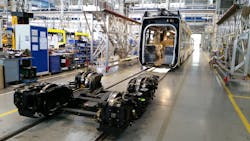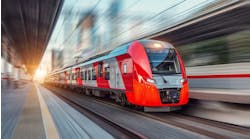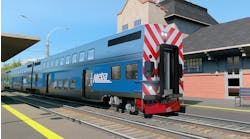While the rail industry is a traditional industry, the world is changing fast.
At a recent press conference, Bombardier Transportation President Laurent Troger gave a perspective on the global rail market and provided an overview of Bombardier's role and where it's headed.
The market has seen steady growth for the past several years because of population growth, increased congestion and the need for mobility. One area within the market that has seen substantial growth is within services.
Troger said it’s a new era where they're having to integrate products and services because more often, the operators are outsourcing their activities and looking for more services. The benefit to Bombardier, he said, is that it gives them information on their product to continually improve it. "It enables us to sustain research and development."
They look to differentiate themselves in total cost of ownership and he stated they’re not a low-cost player. “We want to bring the highest value for them to perform their business.”
“Price is one factor; it’s not the only factor,” he said. “Capital price in railway is one third of total cost. If you buy a train which is five percent cheaper but 20 percent more to operate, you are just losing money.
“The equation operators are now facing is no longer a capital price equation, it is a total cost of ownership equation.”
Many parameters impact business performance. Maintenance, energy used by the train, maintenance; the capital cost is only one third of total cost, Troger said.
He said it’s going to be a significant transformation of Bombardier, that they will be selective in how they bid and on which they bid.
Bringing products to market quickly and as economically as possible is being done by significantly increasing the level of standardization and globalizing their supply chain to develop sustainable competitiveness.
Hennigsdorf Service Center
A tour of Hennigsdorf, Bombardier Transportation’s largest site in the world with more than 650,000 square meters of ground area and more than 2,600 employees, gave a look behind the scenes. The facility handles everything from design, prototype, pre-series manufacturing and final assembly, as well as re-engineering and overhauls.
In the production hall facility there were trains for Berlin and Hamburg in production and the production supervisor, manager and methods manager explained how a new concept for production was being used to improve efficiency.
They went from a static island to a flow line for quick turnaround. For the pre-series, it’s about 40 days for production and when in series production it’s about 10 times quicker, due to the validation process. Between pre-series and series production, the customer tests the train for about 9 months.
In the CRO department, Component Re-engineering and Overhaul, they cover a range of services, from the overhaul and modernization of components to maintenance/revisions, inspections/reports, testing and repairs of all kinds, to complete rebuilding and redesign of components which have gone out of production.
All parts go through testing under operational conditions before being sent out; nothing goes without testing.
Virtual Reality
While touring Hennigsdorf, there was the opportunity to see Bombardier’s virtual reality product presentation. Between the product idea and the start of production, there is about two years’ worth of design taking place. Three-dimensional (3-D) visualization offers a real-size product representation and saves time and money.
An example for the DB S-Bahn illustrated how virtual reality can improve the engineering process where the customer wanted a taller roof for more space within the train car. The roof was raised in each of the spaces by the door and was lower in the seated portions of the train. The customer could then be brought in and “walked” through the train to see what it felt like to be in the space, as opposed to building physical mock-ups. Susanne Hellwig with Bombardier Transportation in the virtual reality center said while virtual reality isn’t meant to eliminate mock-ups, it allows them to postpone them to a later stage in the design process so there are not as many changes.
Walking through the virtual reality car, you could see the spatial relationships and see the color, textures and lighting of the interior. Not only can you view the interior, you can look inside every inch of the train to see every component and assembly in the finished product.
On the S-Bahn train we viewed, there were 440,000 single pieces, down to every single cable and bolt. You can view cross sections of the train from the front, side, top or bottom and you can peel away layers in real time. Components can be assembled and dismantled to see any potential problems.
Human models can be manipulated in the space and the joints appear green, yellow and red to show the strain put on joints in whatever position the models are in. There were two examples with human models we saw, one as a passenger and one as a mechanic. The passenger was in a wheelchair and needed to push the emergency call button. The virtual space allowed us to see how the chair maneuvered to get to the button, how she would reach to the call button and what, if any, stress that put on joints. There was stress put on the arm to reach out and push a button, but as it’s a push and release, your arm doesn’t have to hold that position, so it’s not a problem.
As for the mechanic, there was a panel in the operator cab that would need to be removed to get at a certain component that requires fairly regular maintenance. To reach it and to hold the position long enough, it could show there was too much strain. However, with some design modification, there was a fix that allowed easier access to the space.



